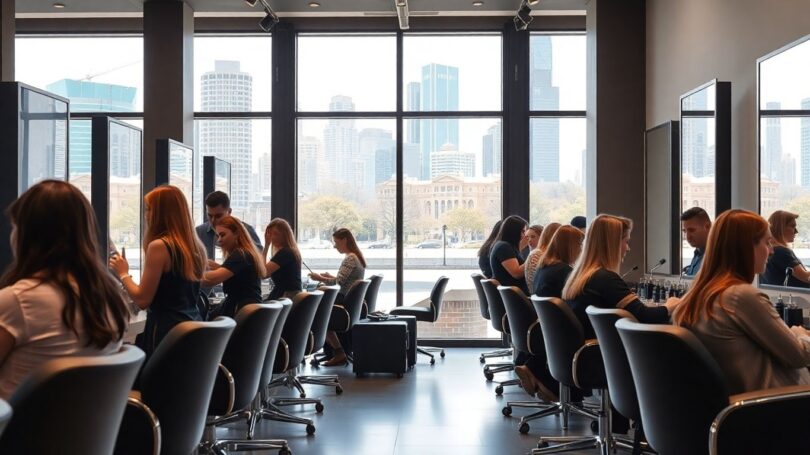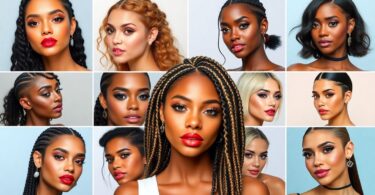Australia’s hairdressing chains are changing fast. Big names, local favourites, and new eco-friendly brands are all fighting for a slice of the market. People want more than just a haircut—they care about the products used, how salons treat the planet, and whether the brand feels right for them. Social media, online shopping, and new technology have made it easier for smaller brands to reach customers, even in far-off places. Salons are also trying to stand out by offering green options, using Aussie ingredients, and bringing in new treatments. Let’s take a look at what’s happening with hairdressing chains Australia in 2025, the trends shaping them, and the brands making waves.
Key Takeaways
- Australia’s hairdressing chains are seeing more competition from both global brands and homegrown businesses.
- Customers are asking for sustainable, cruelty-free, and locally sourced products, pushing salons to rethink what they offer.
- Online shopping and social media are changing how people find salons and buy hair care products, making it easier for new brands to get noticed.
- Eco-friendly moves, like recycling and using less plastic, are becoming standard in top salons across the country.
- Personalised treatments and products made for Australia’s climate are in high demand, especially in cities and remote areas alike.
Market Landscape of Hairdressing Chains Australia
Understanding how hairdressing chains are growing in Australia isn’t straightforward—there’s a mash-up of big household names, regional quirks, and a consumer base that’s picky and changing fast. Here’s what’s happening in the sector as we head through 2025.
Dominant Local and International Brands
Australia’s hairdressing market is crowded, with local brands rubbing shoulders with global giants. Chains like Just Cuts, Franck Provost, and Hairhouse are everywhere in shopping centres and urban streets, offering accessibility and trusted service. International brands (like Toni & Guy) keep the pressure on with their global expertise and trend-driven appeal, while still tailoring services for Aussie tastes.
A quick snapshot of major players:
| Brand | Origin | Typical Location |
|---|---|---|
| Just Cuts | Australia | Shopping centres |
| Franck Provost | France | CBD & upmarket areas |
| Hairhouse | Australia | Malls & suburban hubs |
| TONI&GUY | UK | City & flagship sites |
| Stefan | Australia | QLD-centric |
You’ll also see niche, eco-friendly groups growing but they still fight to grab mass market attention, which often lands in the laps of those old familiar chain stores. If you’re curious about how other industries are experiencing similar growth, check out substantial opportunities for entrepreneurs.
Consumer Preferences Shaping the Sector
Aussies are choosy. People are loyal if the price is right and quality stacks up, but there’s a constant hunt for salons that offer value, authenticity, and transparency. Recent years have brought a bigger craving for:
- Professional-grade treatments once only found in exclusive salons.
- Brands that talk up their cruelty-free, vegan, or Aussie-made credentials.
- Services tailored for hair health (like keratin or scalp repair) over one-size-fits-all cuts.
Also, with folks moving between urban and remote spots, the need for easy-to-access quality services (including affordable colour and style) remains high. Chains that listen to these wants—quick, walk-in cuts or appointments online—tend to do well.
Chains that adapt and make personalisation a reality keep the regulars coming back, while those that ignore changing demands will struggle to stay on the radar.
Impact of Economic and Regional Factors
Running a salon chain in Australia means juggling some complicated stuff. The country’s size and how spread out everything is can make product delivery and staffing a headache. Importing products also means dealing with global delays, fluctuating exchange rates, and pricey logistics—especially rough for smaller brands trying to get their goods into more rural stores.
Big brands have the muscle to absorb these costs or negotiate with suppliers, but indie salons and smaller franchises struggle, especially when it comes to keeping prices competitive. Regional areas may only see a few big chains or miss out on the new, trending products found in the cities.
Some challenges include:
- High costs for imported products and supplies.
- Difficulty maintaining a steady supply chain to rural locations.
- Price-sensitive markets that limit the range of services or products offered.
While the deck sometimes feels stacked against newcomers, those who tackle these hurdles with creativity or local solutions (like local product sourcing or multi-use team roles) often make a mark in their niche, even if growth is slower.
Shifting Consumer Trends in Hairdressing Chains Australia
Growing Preference for Sustainability
The push for eco-friendly and ethical beauty is everywhere these days—especially in Aussie hair salons. A bigger chunk of customers now choose chains offering natural, cruelty-free, and locally made hair products. This is no longer just about ingredients; packaging matters a lot too. People want less plastic, more refills, and clear labelling.
- High demand for sulphate-free and paraben-free products.
- Increase in salons with refill stations or using biodegradable materials.
- Continued boom in local brands using Australian botanicals.
Salon chains stepping up on sustainability are seeing more repeat business, even with tight budgets, as shoppers weigh greener values against price tags.
Demand for Personalised Hair Solutions
Hair isn’t one-size-fits-all and Aussies know it. Social media and beauty creators highlight routines for different hair types—curly, fine, thick, multicultural—and that’s shifting what people look for in salon chains. It’s not just about a trim anymore. Salons need to offer tailored treatments and use products for unique needs: scalp wellness, colour-treated hair, or curl definition all make the shopping list.
What’s driving the shift?
- Interactive digital tools like hair quizzes for product recommendations.
- Rising popularity of virtual consultations and at-home pro treatments.
- Wider range of cultural and texture-specific solutions, especially in multicultural cities.
More customers are also seeking at-home solutions that mimic professional salon results when budgets get squeezed.
Adoption of Climate-Specific Products
Australia’s wild climate—extreme sun, humidity swings—means standard products often just don’t cut it. Many major chains and boutique salons are now pushing lines that protect against UV rays, hydrate dry hair, or handle frizz caused by tropical weather. It’s not just a city thing: even outback customers look for products that tackle sun damage or help with scalp hydration.
| Product Demand | Percentage of Salons (Est. 2025) |
|---|---|
| UV-protectant sprays | 85% |
| Deep hydration serums | 78% |
| Anti-frizz solutions | 74% |
New launches often highlight sun protection, high moisture content, and ingredients like coconut, native plum, or aloe to match Australia’s weather.
The expectation now is that big chains offer climate-specific product lines and services tailored to local environments. This trend is moving even faster as urban salons expand their reach to regional areas—customers everywhere want solutions made for Aussie conditions.
Digital Transformation and E-Commerce in the Hairdressing Industry
Australia’s hairdressing sector is getting a serious tech upgrade—fast-tracked by social media, direct-to-consumer models, and clever personalisation tools. Salons and hair care brands are doing more online than ever, and you can really see the changes both behind the scenes and in customer experience.
Role of Social Media and Influencers
Social media is where Aussies find new hair trends, products, and even salons these days. People aren’t just scrolling past ads—they’re watching tutorials, seeing before-and-after pics, and following stylists on platforms like Instagram, TikTok, and YouTube. It’s made:
- Everyday influencers key for word-of-mouth in hairdressing, often more trusted than ads.
- The rise of culturally diverse campaigns, especially in cities like Sydney and Melbourne, where all sorts of hair types feel represented.
- Real-time Q&A, live demos, and even virtual events that boost engagement and loyalty.
Social media isn’t just about showing off the latest haircut—it’s become the main way for Australian brands and clients to talk, learn, and book services.
Growth of Direct-to-Consumer Models
Direct-to-consumer (DTC) isn’t just something for fashion or electronics. Hair care companies are now selling online, shipping straight from their shop or warehouse to a client’s front door—no middleman in the way. Key things happening:
- Rural and remote clients aren’t missing out; they get the same product options as those in the city.
- Online-only hairdressing brands are popping up and taking a bite out of the big retail stores.
- Subscription boxes and curated product bundles are getting way more common, driving repeat sales.
Table: Change in Hair Care Purchases via E-Commerce (Australia, 2022-2025)*
| Year | % of Total Salon Product Sales Online |
|---|---|
| 2022 | 19% |
| 2023 | 24% |
| 2024 | 29% |
| 2025 | 36% |
Advancements in Personalised Online Shopping
If you thought quizzes were just for magazine fun, think again. Hairdressing chains are leaning into digital personalisation. What’s working right now:
- Online hair quizzes and AI tools that recommend products, catering for everything from scalp conditions to climate-specific needs.
- Virtual consultations and real-time video chats with actual stylists—from your living room.
- Platforms that remember order history and preferences, making reordering faster and smoother.
The digital side of things isn’t just about selling—it’s about helping clients find the right fit, every time.
Between all these changes, Aussie salons and hair care brands are making sure nobody feels left out, whether they’re in the city or out bush. If this is the new normal, it’s one that feels a bit more personal—and a lot more convenient.
Eco-Friendly and Ethical Practices Among Hairdressing Chains
These past couple of years have shown a real push by hairdressing chains in Australia to clean up their act—literally. There’s been a genuine surge in salons committing to greener business models. What does this look like? For starters, many salons now choose biodegradable towels, invest in water-saving basins, and use in-salon recycling programs. Some even offset energy usage with solar panels or team up with local clean-up charities. These initiatives are no longer niche—they’re quickly becoming what clients expect from their local hairdresser.
Salons leading the way in green initiatives commonly:
- Source cleaner energy for daily operations
- Recycle hair, foil, and product packaging
- Use water-efficient washing stations
- Train staff and educate clients on eco-responsibility
The steady growth of green salons is making eco-friendliness the norm rather than the exception, as customers are quick to switch if a competitor aligns better with their values.
Popularity of Locally Sourced Ingredients
Sustainability in hairdressing isn’t just about recycling or energy use. Australian brands are spotlighting local ingredients—like macadamia oil, tea tree, and quandong—to create high-performing hair products. These ingredients not only reduce transport emissions (think: fewer air miles), but also support local farmers and keep profits within Aussie communities. Most consumers can spot the difference in formulas that champion local botanicals. The transparency around where ingredients come from—and how they’re grown—has become a selling point with each new season.
A few repeated trends seen in product development:
- Focus on native Australian botanicals
- Direct supply chain partnerships with farmers
- Open communication about ingredient origins and sustainability practices
Tables are sometimes useful to map what’s trending with ingredient sourcing:
| Ingredient | Region Sourced | Sustainability Focus |
|---|---|---|
| Macadamia Oil | Queensland, NSW | Family-run farms, low-input |
| Tea Tree | Northern NSW | Regenerative farming |
| Quandong | South Australia | Wild-harvested, native |
| Lemon Myrtle | QLD/NSW | Carbon-conscious logistics |
Packaging Innovations for Sustainability
Cutting down on plastic waste is another major win for hairdressing chains aiming to stand out. We’re seeing everything from refillable pouches to solid shampoo bars take up space in salon retail areas. Brands now chase innovation in packaging that’s either compostable, biodegradable or infinitely recyclable. Some even offer a rebate for returning empty tubs. It’s not just about what’s inside, but the whole product lifecycle from shelf to bin—brands get scrutinised for both.
Current packaging solutions changing the scene:
- Solid haircare blocks to replace bottles
- Refillable dispensing stations in salons
- Compostable mail-order pouches and boxes
- Incentives for bottle returns
For more about how eco-friendly business is becoming more profitable, check out Australia’s most profitable businesses for 2025.
The move toward less waste and smarter packaging isn’t slowing down. Brands and salons that innovate with eco-packaging stay ahead, and Aussie shoppers notice the difference at the checkout.
Key Players and Emerging Brands in Hairdressing Chains Australia

Australia’s hairdressing chain landscape is definitely packed at the moment. You’ve got the big names that everyone knows, some indie gems popping up left and right, and international heavy hitters trying to carve their own patch. It’s a market that rewards both size and innovation, but leaves little room for brands that can’t stand out.
Profiles of Top Established Chains
If you walk through any shopping centre, these brands are hard to miss:
| Brand Name | Origin | Famous For | 2024 National Outlets |
|---|---|---|---|
| Just Cuts | Australia | Quick, no-fuss cuts | 210 |
| Price Attack | Australia | Products + services | 70 |
| Stefan | Australia | High service, bold colour | 35 |
| Franck Provost | France | Luxury salon experience | 22 |
| TONI&GUY | UK | Trend styles, training | 19 |
Most of these chains keep their edge with nationwide marketing, regular staff upskilling, and in some cases, their own branded product lines. Many of them were among the first to launch online appointment systems and sell products in both physical and online stores.
Rise of Indie and Boutique Salons
Not everyone wants the chain experience. In the last couple of years, boutique salons have gained solid ground by:
- Focusing on natural, vegan, and local products.
- Creating intimate, relaxed environments where regulars feel like family.
- Offering highly personalised services – think one-on-one consultations or custom scalp treatments.
This trend means that small operators, while facing stiff competition, still find plenty of customers willing to pay for quality over convenience. Many boutiques are also tuning into sustainability trends, with refill stations for shampoo and upcycled furniture popping up in the inner suburbs of major cities.
International Brands Entering the Market
Heavyweight global chains have their eyes on Australia, especially with more people willing to spend on premium hair care. Recent years have seen:
- Big European brands like Jean Louis David looking to establish a physical presence.
- More import of Asian haircare concepts focused on scalp health.
- International salon brands launching Australian webshops, letting Aussies shop direct without the overheads of local stores.
While established salon chains thrive by scale, success for new entrants depends on creative marketing, unique services, and watching what local shoppers actually want.
The market doesn’t make it easy for newcomers, but with a bold strategy or a real gap in the market, new brands can still make their mark – at least in the right postcode.
Regional Insights and Market Expansion for Hairdressing Chains Australia

Trends in Major Urban Centres
Sydney, Melbourne, and Brisbane are still the main battleground for hairdressing chains, with these cities drawing on diverse populations and a strong appetite for beauty experiences. Bigger chains cluster here for a reason: customers expect everything from quick walk-ins to custom colour sessions and advanced hair health treatments. Newer high-performance products—like those focused on scalp health or colour retention—are especially popular.
- Multicultural cities are pushing demand for brands to cater to a wider mix of hair types, from curly to chemically straightened.
- Sustainable salon practices are getting more visible in big cities.
- E-commerce expansion means even city dwellers compare prices and book online before stepping into a salon.
Big city salons set the pace for style and services, but customer expectations move fast, so chains need to keep updating their offer or risk losing out.
Challenges in Rural and Remote Locations
Regional and remote areas face the biggest hurdles. Access is an ongoing issue—salon choices are often slim, and getting hold of popular products can be tough. Shipping costs and delays hit both the customer and the business. Still, digital channels are now helping rural Australians skip these barriers :
- People rely more on direct-to-door e-commerce, especially for exams like scalp or colour damage solutions.
- Local salons are becoming creative: partnerships to offer city-quality products, pop-up visits, and online video consults.
- Supply chain disruptions (like late imports or rising costs) hit harder in these outlying places, so locals often pay more or go without.
| Region | Salon Chains Present | Online Booking Uptake | Main Challenge |
|---|---|---|---|
| Sydney | High | Very High | High competition |
| Regional NSW | Medium | Growing | Access/costs |
| Northern QLD | Low | Moderate | Distribution/logistics |
| Perth Metropolitan | Medium | High | Product variety |
| Remote NT | Very Low | Low | Availability, pricing |
Diversification in Service Offerings
Lots of chains are widening their menus to suit where they are:
- Subscription and bundle services for at-home care products, especially helpful for those outside metro areas.
- More inclusive services—braiding, textured hair care, and treatments for sensitive scalps.
- Partnerships with local suppliers for unique treatments (for example, using Australian ingredients or indigenous hair routines).
- Flexible models, like express salons for quick trims in shopping malls versus full-service locations with spa extras in city centres.
Regional expansion means salon chains can’t just copy-paste a city model; they need to adapt and listen to the local community.
As Australia’s hair care sector grows—expecting to hit nearly $1.9 billion in retail value by 2030 hair care market is projected to grow—chains are being pushed to work smarter and closer with every type of customer, wherever they live. The future looks local, online, and surprisingly tailored to the patchwork of Australia’s geography.
Innovation and Product Development in the Australian Hairdressing Market
Modern hairdressing chains in Australia have been forced to get creative. Rapid changes in how people care for and think about their hair, plus fierce competition, have pushed brands to rethink what sorts of products and services they launch. Salons aren’t just about a quick trim anymore; they’re about advanced treatments, smart product ranges, and celebrating local ingredients and culture.
Advanced Scalp and Hair Health Treatments
Aussies now expect much more from their hair visit. Scalp health, in particular, is getting close attention. Chains are offering:
- Bond-repair and keratin therapies aimed at restoring hair from chemical and heat damage.
- Professional scalp and hair diagnostics – everything from in-salon assessments to online quizzes for at-home shoppers.
- DIY at-home treatments that mimic salon results, a necessity for rural customers who can’t visit the city as often.
These therapies are popular for both their salon results and for extending that "fresh from the hairdresser" feel much longer at home.
Launch of Multi-Functional and High-Performance Ranges
Product launches are focusing on performance—people want more out of a bottle than ever before. Brands are now introducing:
- Shampoos and conditioners that address several concerns at once, like hydration, frizz control, and colour protection.
- Leave-in formulas that offer sun protection, anti-pollution, and humidity blocking for Australia’s varying climates.
- Products for special hair needs, like anti-dandruff for dry areas or curl-defining creams for diverse hair types.
Comparison Table: Key Features in 2025 Hair Products
| Product Feature | % of Chains with Launches (2025) |
|---|---|
| Multi-purpose Haircare | 67% |
| Climate-Adaptive Products | 52% |
| Colour & Damage Solutions | 80% |
Integration of Indigenous Ingredients and Traditions
Australia’s native botanicals are making their mark. Leading hairdressing brands look locally for inspiration, drawing on:
- Ingredients like macadamia oil, tea tree, and quandong, with known scalp and hair benefits.
- Collaborations with First Nations businesses to incorporate traditional knowledge and respectfully source botanicals.
- Story-led marketing to show cultural links and environmental responsibility.
This isn’t just a trend—it’s changing how brands select, source, and talk about their products in salons and on shelves. Some businesses now dedicate whole lines to Australian-grown and Indigenous ingredients, giving consumers a more authentic—and often more effective—option.
Innovations in the Australian hairdressing scene come from real conversations between brands, communities, and consumers, rather than just following overseas fads.
Conclusion
So, that’s the lay of the land for hairdressing chains in Australia as we head into 2025. The market is buzzing, with big names still holding their ground and smaller, eco-minded brands making some real noise. Aussies are clearly keen on looking after their hair, but they’re also thinking about what goes into their products and how those choices affect the planet. E-commerce and social media have made it easier than ever for people to find exactly what they want, whether that’s a fancy salon treatment or a cruelty-free shampoo delivered to their door. It’s not just about looking good anymore—it’s about feeling good about your choices, too. With all these changes, it’ll be interesting to see which brands keep up and which new ones pop up next. One thing’s for sure: hairdressing in Australia isn’t slowing down anytime soon.
Frequently Asked Questions
What are the biggest hairdressing chains in Australia right now?
Some of the top hairdressing chains in Australia include Just Cuts, Hairhouse, and Price Attack. These brands have many salons across the country and are well-known for their wide range of services and products.
Why are more people choosing eco-friendly hair salons?
Many Australians care about the environment and want to support businesses that use natural products, avoid animal testing, and use less plastic. Eco-friendly salons meet these needs by offering greener choices and using local ingredients.
How is technology changing hairdressing in Australia?
Technology is making it easier for people to book appointments online, get hair advice through virtual consultations, and buy products from home. Social media also helps salons and brands reach more customers and share the latest trends.
Are there special hair care products for Australia’s climate?
Yes, many brands now make products that protect hair from the sun, humidity, and dry weather. These products help keep hair healthy and shiny, even in Australia’s tough climate.
What new trends are shaping the hairdressing industry in 2025?
People are looking for more personalised hair solutions, like custom treatments for their hair type. There’s also a big focus on sustainability, with brands using eco-friendly packaging and natural ingredients. Digital shopping and influencer advice are also very popular.
How can I find a good hairdressing chain near me?
You can search online or use social media to find salons with good reviews. Many big chains have websites where you can check locations, services, and prices. It’s also helpful to ask friends or family for recommendations.








